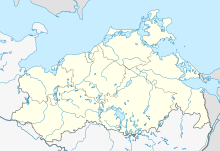Nature reserve Peenetal west of the Gützkower ferry dam
Coordinates: 53 ° 55 ′ 9 ″ N , 13 ° 24 ′ 31 ″ E
The Peenetal nature reserve west of the Gützkower Fährdamm was a 310 hectare nature reserve in Mecklenburg-Western Pomerania . It was located north of the Peene , two kilometers southwest of the city of Gützkow . It was placed under protection on November 5, 1990. On May 20, 2010 it opened in the larger nature reserve Peene Valley from Jarmen to Anklam .
The state of the area is satisfactory. Due to the large peat with the connection trenches for Peene nutrient-rich river water reaches far into the mesotrophic flow Moor . The protected area may not be entered. Only to the north is a public path along the Swinow to the Peene.
History and water balance
The Peene Valley was formed at the end of the last Ice Age . Melt water running off led to erosion of the valley floor up to five meters deep. The valley was flooded by the rise in sea level in the Baltic Sea as part of the Littorina transgression , calcareous muds sedimented with a thickness of half a meter and a current five meters thick bog grew up. In the Swedish matriculation cards from 1694, the areas are shown as wet pastures. Large-scale peat cuttings were made from the 18th century to the 1960s . Pasture areas were converted to arable land, fertilized and drained through ditches in the first half of the 20th century. The area has not been used since 1975 and the areas are subject to succession. Wet meadows are maintained along the edge of the valley. The area has been part of the major nature conservation project Peenetal-Landschaft since the 1990s . Development measures consist of the dismantling of the ditch system and the maintenance of the wet meadows in order to maintain a forest-free and nutrient-poor moor. The protected area is supervised by the student Lamarck Circle of the University of Greifswald.
Flora and fauna
The protected area includes a unique, diversely structured moor landscape. About a third of the area is covered by open water surfaces that go back to deep machine peat cuttings. Here settle stoneworts -Grundrasen with crab claw , vulgar water hose and numerous species of dragonflies . Willow bushes line the waters edge. Where calcareous groundwater flows on the edge of the valley, there are limestone rush and Kleinseggenriede, which extend into the central part of the area. Typical representatives here are, in addition to numerous types of sedges , flour primrose , common butterwort , swamp heart leaf , swamp cruciferous , Nordic bedstraw , broad-leaved cotton grass , small water hose and types of moss . In the east of the area there are wet meadows with pipe grass , globe flower , Prussian laser herb, caraway silge, broad-leaved marsh orchid and dyer's notch . The dry northern slopes of the valley are covered with grassy grass , spring sedge , mountain clover , common sorrel , dyer's chamomile , meadowsweet , mountain hairline and common dost . The area has many day and moth species on, some of which are very rare and threatened with extinction. The black tern and spotted rail are worth mentioning as breeding birds .
literature
- Nature reserve Peenetal west of Gützkower Fährdamm 251 . In: Ministry of Environment Mecklenburg-Western Pomerania (Hrsg.): The nature reserves in Mecklenburg-Western Pomerania . Demmler-Verlag, Schwerin 2003, ISBN 3-910150-52-7 , p. 236 f .
Web links
- Large-scale nature conservation project Peenetal landscape
- Map portal environment of the State Office for the Environment, Nature Conservation and Geology Mecklenburg-Western Pomerania ( information ) with geodata
- Homepage of the protected area supervisors (Lamarck Circle of the University of Greifswald)


